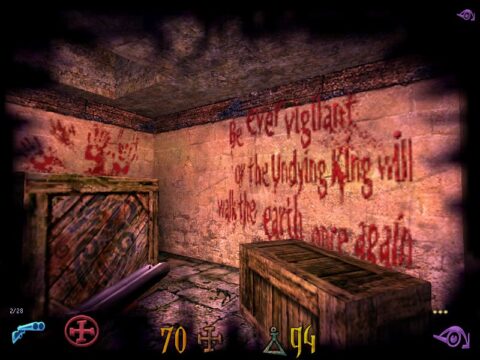
Clive Barker’s Undying
Written by: Rik
Date posted: November 4, 2007
- Genre: Action
- Developed by: Electronic Arts
- Published by: Electronic Arts
- Year released: 2001
- Our score: 8
Although I could easily pretend otherwise, I have to admit that I hadn’t got the first clue who Clive Barker was before his name was attached to this game. So, for those of you who aren’t shouting ‘But he wrote and directed Hellraiser!’ at the screen right now, Mr Barker is a well-known horror author who has (of course) also been known to dabble in films. Mainly, though, he writes novels for a living, and while there are clearly some gamers out there who have read more than two books in their whole life, it has to be said that EA were taking a significant gamble on the literary knowledge of the gaming community when they decided to slap his name on the box. Despite generally positive murmurings from critics, huge sales were not forthcoming, plans for a sequel were shelved, and whoever thought the whole thing was a great idea in the first place was immediately fired (probably).
Speaking of which, despite the title, Undying isn’t a project Barker helped develop from the ground up, and a significant amount of the content was actually already in place by the time he came on board to do some work on developing the storyline and characters. While in these circumstances it may seem like a bit misleading to make so much of Undying being ‘his’, in fairness those are the elements in a game that you’d expect to be relevant to his areas of expertise, with a mild level of research indicating that he actually had quite a significant say in shaping the final product.
You play Patrick Galloway, a brooding muscle-bound hero type also known to dabble in magic from time to time. A handful of years after the end of the First World War, Patrick receives an urgent letter calling him to the estate of his old friend Jeremiah Covenant, who regales him with tales of strange happenings at the estate. With Jeremiah suffering from ill health and having saved Patrick’s life during the war, our hero takes it upon himself to drive away the supernatural forces that are afflicting his friend’s final years. It seems that some childhood tomfoolery with matters of the occult brought about a curse on the Covenant family, driving Jeremiah’s siblings to their death, only for them to come back to haunt the old estate and their surviving brother.
The long and the short of all this is that you start the game sneaking around a creepy old mansion just waiting for something horrible to happen. To give much more away would probably be to spoil the game for those who haven’t played it, so I won’t, but needless to say you eventually progress into the estate and beyond and witness some pretty weird stuff along the way. Horror fans and literary types might also be interested to know that Barker has previously acknowledged Undying’s ties to the work of Edgar Allen Poe and H.P Lovecraft. On the other hand, if you happen to be a semi-literate ignoramus like myself, don’t worry: we’ll start talking about the shooty bits soon.
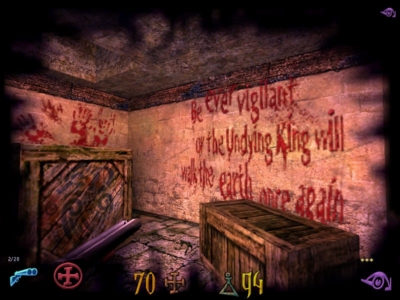
Using Scrye can spring the odd surprise. I preferred it when this was just a dark room with a couple of crates in.
The story is carried along by a combination of in-engine cut-scenes and Patrick’s journal, which is normally updated once you come across anything of note, and you can read your alter ego’s thoughts on whatever item or event you’ve both just witnessed. The cut-scenes are fairly intermittent, and early on they mainly take the form of rather clipped conversations with the various servants in the mansion, who display a redoubtable devotion to their daily chores despite the strange events unfolding at their place of work. I don’t think it’s too controversial to reveal that quite a number of these poor blighters meet a grisly end before the end of the game, but those who survive seem happy enough to hang around and provide you with mildly useful hints (and presumably to clear away the corpses of ex-monsters and former colleagues that litter the house).
Clearly, there’s plenty of mileage in the ‘haunted mansion’ scenario, and Undying exploits this well in its early stages, with the usual array of spooky noise, doors slamming shut and lights going out when you’d least expect, and the game’s more buttock-clenching moments are normally to be found here. There’s more to the game than that though, and the claustrophobic tension of the mansion is eventually left behind as you guide Galloway through a variety of locations past, present and, er, otherworldly. The locations lend themselves to different sorts of adversary, too, and while you find yourself up against flesh-eating monsters and mysterious ghostly slugs in the mansion, later on you’ll be battling skeletons in a graveyard, travelling back in time to dispense unholy justice to some murderous monks, or venturing into the netherworld to find yourself confronted by mysterious cloaked beings who float above you for a while before dropping exploding skulls on your head.
The variety also extends to the weapons at your disposal. According to the game box, ‘you are armed with arcane magic and a six-shot weapon of forged metal’, which is a reasonably poetic way of saying that you start the game with a revolver in your hand and a moderate amount of magical ability at your disposal. While initial enemies can be dispatched with a well-aimed bullet to the head, as you progress you’ll need to rely more on your ever-expanding array of spells. For one thing, the 1920s setting means that there aren’t the usual machine guns and rocket launchers lying around, and though the revolver (and, later, the shotgun) pack a significant punch, they also don’t hold much ammo at a time and take an age to reload – which is bad news when there’s a room full of nasties to deal with. Mastering the use of combat-based spells alongside your standard weapon is essential to your survival early on, and as your foes grow more powerful you’ll find that magic is the only way to take them on.
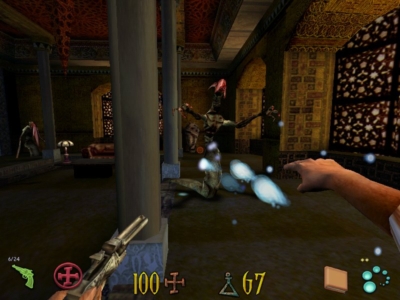
These buggers come up through the floor and sway about menacingly. Luckily, you can shoot blue stuff out of your hand.
The spells at your disposal aren’t all for combat, though, and others provide help in other ways, whether it’s by temporarily boosting your abilities (Haste), protecting you from enemy attacks (Shield) or allowing you to resurrect slain enemies to fight on your side (Invoke). While there are some nice touches – such as when you use Invoke on a human enemy, making them commit suicide on the spot (well perhaps ‘nice’ isn’t the right word) – some of the spells don’t seem to have much practical use and can be mostly ignored, except for a couple of slightly contrived situations where the game forces you to use them in order to progress. One of the best and most useful spells is Scrye, which has multiple functions, among them the ability to witness events of the past, and is responsible for some of Undying’s coolest moments (see I Scrye With My Little Eye for more).
The overall impression is of a very well put-together game. Though there’s nothing groundbreaking here, plenty of thought and effort has clearly gone into producing something that stands out from the crowd. Though the Unreal engine creaks a little bit at times, the levels are well designed, boasting some impressive architecture, and there are plenty of neat graphical touches that catch the eye along the way. Pacing is also good, with the right balance of exploration and combat maintained throughout, ensuring that aimless wandering around is kept to a minimum (though it’s worth mentioning that the game does force you in the direction it wants via strategic locking and unlocking of doors) and that combat rarely descends into a tedious blastathon.
Sound is used to good effect, with a general atmosphere of bleakness and solitude occasionally punctuated by a spot effect to raise the heart rate and keep you on your toes. However, despite the occasional shock and more than a few tense moments, there’s nothing in Undying to keep you awake at night. Though it’s clearly supposed to be A Scary Game (backed up by the doom-laden packaging and ridiculously OTT marketing spiel about it being ‘a game of unparalleled terror’) I have to say, as a certified chicken when it comes to scary games (I never recovered from the childhood trauma caused by the 8-bit version of Aliens), that while it’s certainly involving and unsettling at times, there’s little contained within likely to terrify anyone but the most easily frightened.
Those expecting big things from the story are likely to be disappointed, too, and once you progress beyond a certain stage it seems pretty obvious what you’re going to have to do to finish the game. That’s not to say that the rest of the game is predictable, only that your interest in the narrative itself is likely to dwindle from that point on. The voice-acting isn’t the best, either, with some seriously dodgy accents on offer, including that of Patrick, who seems fairly disinterested with the script in general. While we’re on the subject of our hero, it also has to be said that as the game progresses you feel he’s taking his loyalty to his old war buddy to rather extreme lengths, and there are times when he could really be forgiven for forgetting about the whole thing and just legging it home. You might feel the same way about Undying‘s final sections: the ending really is quite yawnsome, and unfortunately feels more like something tacked on from Unreal than a genuine crescendo to what’s gone before (especially the penultimate section – which is quite brilliant).
Still, it would be churlish to focus on the negative when Undying so clearly remains a polished and entertaining title. Although it doesn’t do anything revolutionary, with its 1920s setting and focus on magic rather than muscle, it does offer a reasonably original slant on a genre normally dominated by modern-day action and sci-fi clichés. And so, as ever, in the unlikely event that the FFG seal of approval might have some influence on your game-purchasing decisions, we heartily recommend it to you.

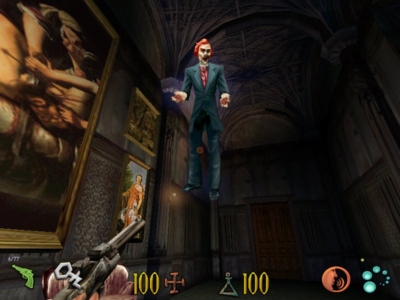
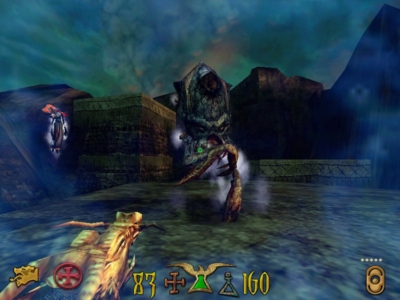

 Posts
Posts